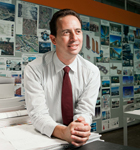
1946: Walter bird’s first radome
An iconic photograph of the engineer (right) shows him standing atop the structure after having just used a rope to scale the wall in his bare feet. “It all started because the military needed a way to protect their radar facilities,” Capezzuto says. “They experimented with different materials and eventually developed a structure that was like blowing up a balloon around the radar. The question then became: Who’s going to produce these?”
1956: birdair is founded
Building on his work for the US military and the Cornell Aeronautical Laboratory, Bird answers the government’s call for the mass production of air-supported fabric structures by forming his own firm. However, he also recognizes the profit potential of his new product in the private sector, and he soon begins to look for ways to promote it. “Walter Bird was a pioneer,” Capezzuto says. “In this business, there are very few people who don’t know his name.”
1957: a magazine takes notice
Life magazine profiles Bird and the new technology and features the company on its cover. One of the highlights of the article is Bird’s own swimming pool, which is enclosed by an air-supported structure during the winter and offers a preview of what homeowners might be able to do in the future. This new idea in engineering design soon becomes an intriguing new option in the residential market.
1970: a fair, a new relationship
The World’s Fair is held in Osaka, Japan, and Birdair is commissioned to develop the roof for the US Pavilion. It is here that Bird first meets representatives from Taiyo Kogyo, a Japanese company also in the tensile-membrane industry. The two firms establish a relationship that flourishes so well that Taiyo Kogyo eventually becomes Birdair’s controlling shareholder.
1975: entering the sports sector
Birdair installs the roof of the Pontiac Silverdome in Pontiac, Michigan. The thin covering is made of PFTE, making it highly durable, weather-resistant, and impenetrable by UV rays. This project marks Birdair’s first foray into the sports sector—a niche in which the company eventually becomes a major player. “The reason this technology is special is because it can visually define a facility, a city, and sometimes an entire region,” Capezzuto says.
1981: A major airport project
Engineers at Birdair develop the 4.5 million-square-foot roof of the Hajj Terminal at the King Abdulaziz International Airport in Jeddah, Saudi Arabia. Astronauts report being able to see the white roof reflecting from space. The structure is still the largest tensile-membrane roof structure in the world.

1992–1994: a lightweight alternative
Birdair constructs the roof of the Georgia Dome. It weighs seven pounds per square foot whereas conventional materials could have weighed up to four times as much. Then, in 1994, the firm completes the dramatic yet feather-light roof of the Denver International Airport (left).
2009: a new Innovation
Birdair debuts its Tensotherm product with Lumira aerogel. “Until recently, it was considered impossible to insulate a PTFE roof effectively without sacrificing its daylighting capabilities,” Capezzuto says. Tensotherm is more energy-efficient, pressing a superlight insulating layer between two layers of Teflon. Its 95 percent air content allows Birdair to claim it as “the lightest solid material in the world.” This same year, the firm completes work on Cowboys Stadium (below).


2012: green roof membranes
Birdair installs 3,000 square feet of roofing for the Staten Island Children’s Museum in New York, and it also builds the museum’s free-standing Meadow Structure (bottom). For the first time, the company attaches photovoltaic cells directly to the PTFE fiberglass membrane, enhancing sustainability.
2013: a developing product
Capezzuto predicts that a membrane application called ethylene tetrafluoroethylene (EFTE) will gain increasing popularity in the United States because its transparency levels can be controlled and it has insulating capabilities. “The world saw this technology implemented in a stunning way with the Water Cube at the Beijing Olympics in 2008,” Capezzuto says. “It has been used extensively in Europe and Asia, and indications are that it will be incorporated into many future building designs here in the United States.”
2014: preparing for the world cup
Capezzuto hints that Birdair has a number of high-caliber new projects in planning for the next few years. “We’ve already got three contracts for the World Cup in Brazil in 2014,” he says, “and we couldn’t be more excited.” ABQ


